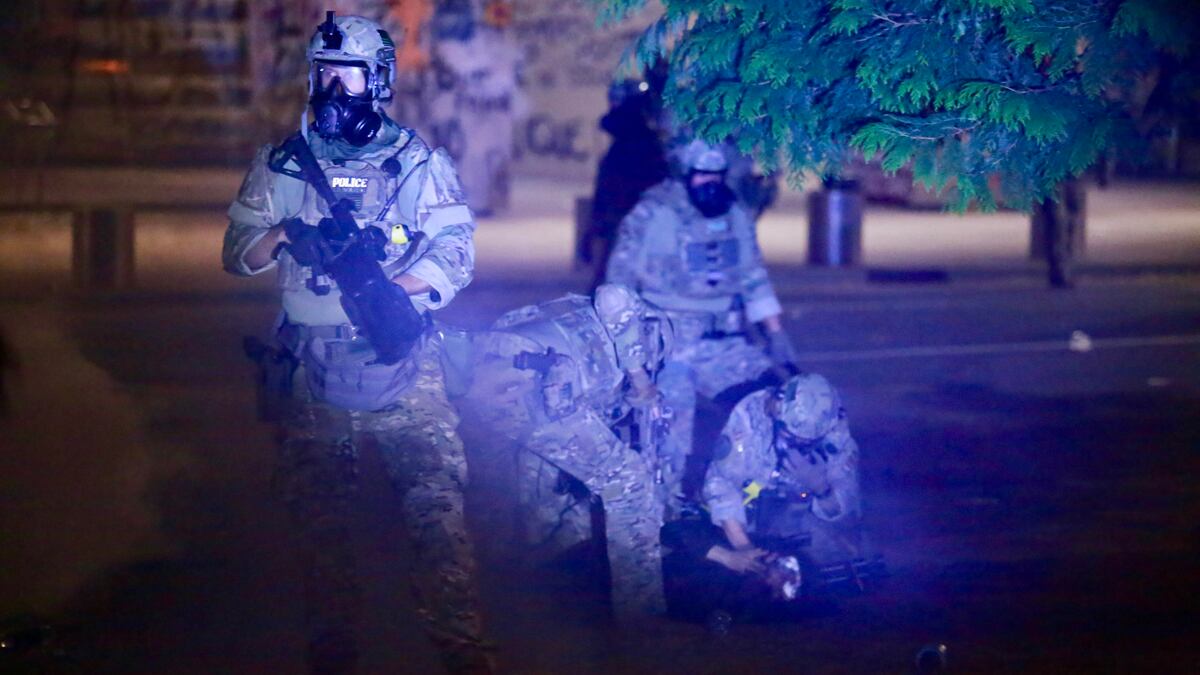Whose streets? Trump's streets.
For the past two weeks, federal officers have patrolled the blocks surrounding the Mark O. Hatfield United States Courthouse. That's thanks mostly to President Donald Trump, who deployed the Department of Homeland Security to at least three U.S. cities that had seen significant street protests—Portland, Seattle and Washington, D.C.
The sight of armed federal officers—who look dressed for overseas combat or the U.S. border they are trained to protect—is an alarming one for many citizens. The image summons memories of other moments of civil unrest in U.S. history: National Guardsmen shooting college students at Kent State in 1970, or federal troops responding to the Rodney King riots in Los Angeles in 1992.
In fact, this is at least the second time federal officers have confronted Portland protesters during the Trump era: In 2018, they cleared a camp that blocked the entrance to U.S. Immigrations and Customs Enforcement offices in the South Waterfront.
This time feels different, however: For one thing, the president is making a show of force in an election year. He sent officers here following a June 26 executive order to protect national monuments and buildings—part of his campaign to keep statues of historic figures from being "defamed" by those who see them as symbols of oppression.
On July 13, Trump boasted that his agencies curbed an uprising in Portland that local cops couldn't control. "We've done a great job in Portland," Trump said. "Portland was totally out of control. We very much quelled it, and if it starts again, we'll quell it again very easily. It's not hard to do, if you know what you're doing."
In response, state and local officials have fumed—or said little. After all, they have been complaining for weeks that "agitators" were setting fires and wreaking havoc. Portland Police Chief Chuck Lovell says the feds follow a different chain of command than his bureau, and Mayor Ted Wheeler says he can't oust them from the city. On July 14, he told the acting U.S. secretary of Homeland Security that he wanted federal officers to leave town. "We do not want or need their help," he wrote on Twitter.
It did not take long for Trump's officers to go on the offensive. On July 11, one officer of the U.S. Marshals Service shot a protester in the head with a projectile. The protester, named Donavan LaBella, underwent facial reconstructive surgery, and remains in serious condition. The U.S. Department of Justice's Office of the Inspector General is investigating the incident to determine if the officer violated protocol.
The bloodstain left by LaBella on the sidewalk of Southwest 2nd Avenue is the image by which this deployment is likely to be measured. But we gathered a few other numbers that help tell the story.
Days federal officers have actively patrolled Portland protests: 14
The first recorded arrest happened on the evening
of July 2.
Number of agencies active in Portland
protests: 4*
Department of Homeland Security, U.S. Marshals Service, Federal Protective Service and U.S. Customs and Border Protection and Border Patrol Tactical Unit (BORTAC) have patrolled the protests. *The FBI has assisted with investigative follow-up on select arrests.
Minimum number of protesters federal officers have arrested since July 3: 19
Number of protesters federal prosecutors have charged since July 3: 13
Maximum sentence those charges carry: 10 years in prison
Number of people charged after shining a green laser in officers' eyes: 4
Number of times a Texas man struck a federal officer with a hammer at a July 10 Portland protest: 3
Monetary damage the feds say the Mark O. Hatfield U.S. Courthouse has sustained: $50,000
Yards from which a man shone a green laser at officers before they arrested him: 40
Width in feet of a "flimsy" plastic shield a protester was carrying before the feds arrested her: 2.5

